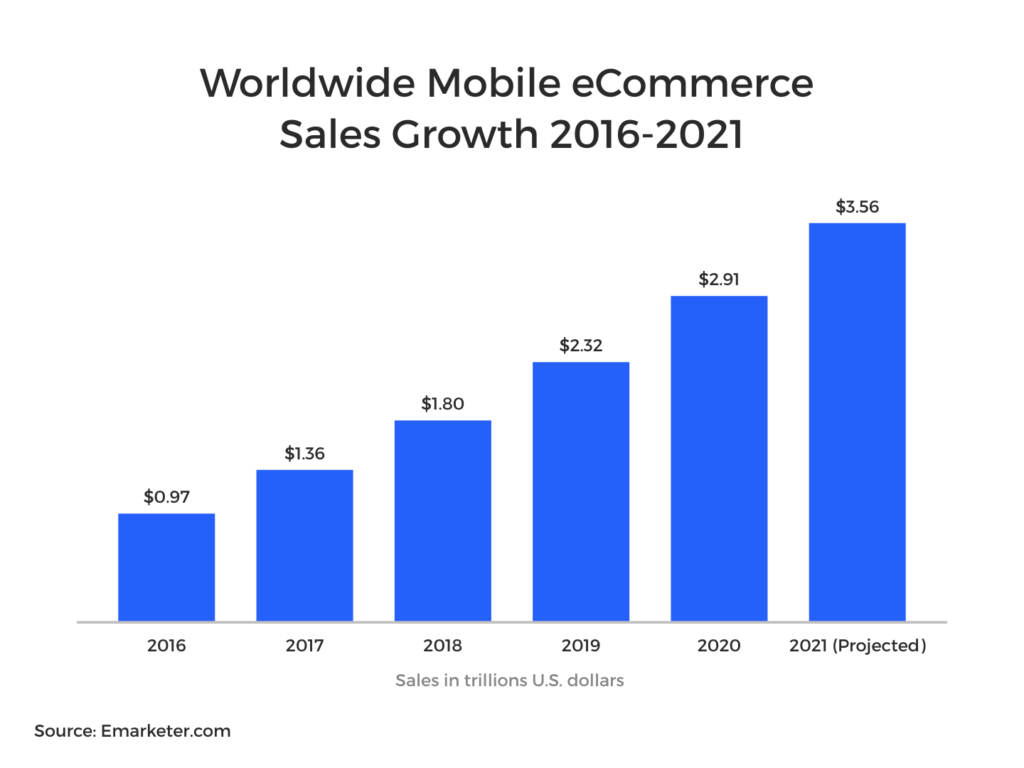Pay Attention to the Fastest Growing Area of eCommerce
Table of Contents
When it comes to ecommerce, mobile is the place to be and effective in-app payment solutions are critical to success. Not only is mobile experiencing the fastest growth rates, but it is also on track to become the overwhelmingly predominant channel in the very near future. With an average growth rate of over 33% per year since 2016, mobile is projected to account for nearly three-quarters of all ecommerce by 2021.1
Broadly, mobile ecommerce can be broken down into in-app and mobile website shopping. Of the two, in-app is by far the dominant choice for global consumers. It’s not hard to see why: one recent study found that app users spend over 18 times more minutes per month shopping than website users.2
Apple and Google Both Have Rules for What In-App Payment Solutions You Can Use
By far the most dominant technology platforms for in-app mobile ecommerce are Apple and Google. Both providers have rules and restrictions for when you have to use their checkout and when you can use a 3rd party mobile payment gateway. Needless to say, it is critically important to make sure that your app follows these rules.
Apple In-App Purchase Rules:
- Apple has rules about whether you are required to use Apple’s in-app purchases or a 3rd party Mobile Commerce Payment System in your app.
- Apps that let users purchase digital items require Apple in-app purchases, whereas apps that sell you real-world goods and services are required to use a 3rd party in-app payment processor.
Google In-App Purchases for Android:
- Developers charging for apps and downloads from Google Play, offering products within a game or access to game content must use Google Play In-App Billing.
- Developers offering products within another category of app downloaded on Google Play must use Google Play In-App Billing as the method of payment, except for the following cases: payment is solely for physical products OR payment is for digital content that may be consumed outside of the app itself (e.g. songs that can be played on other music players).
If you are selling physical goods or services via your app, you’ll need a 3rd party in-app payment solution that meets your needs – and you should expect the following features and capabilities from any in-app payment gateway solution.
Five Must-Haves for In-App Payment Solutions
1. Personalization
A review of case studies conducted by Gartner found that the effective application of personalization boosts engagement and decreases cart abandonment while increasing both revenue and conversion, often by double-digit amounts as high as 70%.3
Examples of personalization include localization for currency type and language, as well as previously used payment methods and options to auto-populate for billing, shipping and contact info.
2. Customization
A shopping and checkout experience that seamlessly integrates with your app is essential. Choose a solution with an Android Payment SDK and an iPhone Payment SDK. Additionally, some mobile payment gateways provide hosted solutions that can be customized with brand logos, fonts, colors and UI to provide a more seamless experience for non-technical users.
3. A Mobile Payments Gateway that Includes Local Payment Methods
While mobile may be a truly global platform, the preferred method of payment varies widely not only from region to region but also between neighboring countries. In Western Europe, for example, credit cards are the preferred mode of payment with the notable exceptions of direct bank drafts in The Netherlands and debit cards in Germany.4
The methods that consumers like to use to make payments vary significantly by region and country. That’s why merchants need to offer a cards+ solution that automatically offers your customers their preferred payment methods based on their location.
Here’s a look at popular payment methods in major ecommerce markets around the world.
Brazil – Popular payment methods include:
- Credit Cards (Visa, Mastercard, Amex, Elo, Hipercard)
- Boleto
- Bank Transfer (Banrisul, SafetyPay)
Mexico – Popular payment methods include:
- Debit and Credit Cards (Visa, Mastercard)
- Bank Transfers (SPEI)
- Cash at Convenience Store (7-11)
UK – Popular payment methods include:
- Debit and Credit Cards (Visa, Mastercard, Maestro, JCB AMEX)
- Bank Transfers (Faster Payments, Bacs)
Singapore – Popular payment methods include:
- Credit Cards(Visa, Mastercard, AMEX, Union Pay, eNETS)
- Bank Transfers (PayNow)
- Cash at Convenience Store (SoCash)
- eWallets (GrabPay)
For details on additional countries, download our regional guides for Latin America, Europe, Middle East & Africa and Asia-Pacific.
4. Seamless Integration
Today’s consumer has one simple metric – things have to work immediately with a minimum of input or else they will move on to another site to complete their purchase. In this zero-tolerance environment, in-app payments must be fast, robust and intuitive. Having one system to cover all regions, methods of payment and types of functionality is a big plus in delivering this level of service.
A focus on omnichannel delivery is a way to make full use of the potential presented by seamless integration. Omnichannel bridges across all platforms, from browser to apps to in-store point-of-sale. It makes possible the ability to offer data-driven personalization.
5. Compliance and Fraud Monitoring
Fraud is always a concern and compliance can be difficult, especially when doing business internationally. Any solution should simplify PCI-DSS compliance, have the ability to process 3D Secure 2.0 transactions, and make use of data tokenization to enhance security. Ultimately, the best practices increase the speed and reliability of performance without affecting the customer experience.
Deliver In-App eCommerce Success
With mobile ecommerce increasingly dominated by in-app purchases, the stakes have been raised for all merchants. It can be an incredibly complex task to offer the fast and intuitive experiences that customers demand and the last thing you need is increased cart abandonment because you don’t offer a smooth experience or the right payment methods.
Using Rapyd Collect Online for Your In-App Payment Solution
Rapyd Collect lets you accept credit and debit cards, bank transfers, ewallets, and even cash in more than 100 countries. Your customers’ preferred payment methods are automatically offered based on their location, so checkout always feels local and more customers can buy from you. And our in-app payments SDK for Android and iPhone provide a world-class developer experience.
Learn more about Rapyd Collect Online
Sources:
- https://www.oberlo.com/statistics/mobile-commerce-sales#:~:text=Mobile%20commerce%20sales%20are%20projected,two%20times%20that%20of%202016.
- https://jmango360.com/wiki-pages-trends/mobile-app-vs-mobile-website-statistics/
- Gartner report: How to Improve Customer Experiences in Digital Commerce Payments
- Going Global: Rapyd’s Guide to the Fastest Growing Local Payment Methods for 2020
Subscribe Via Email
Thank You!
You’ve Been Subscribed.




